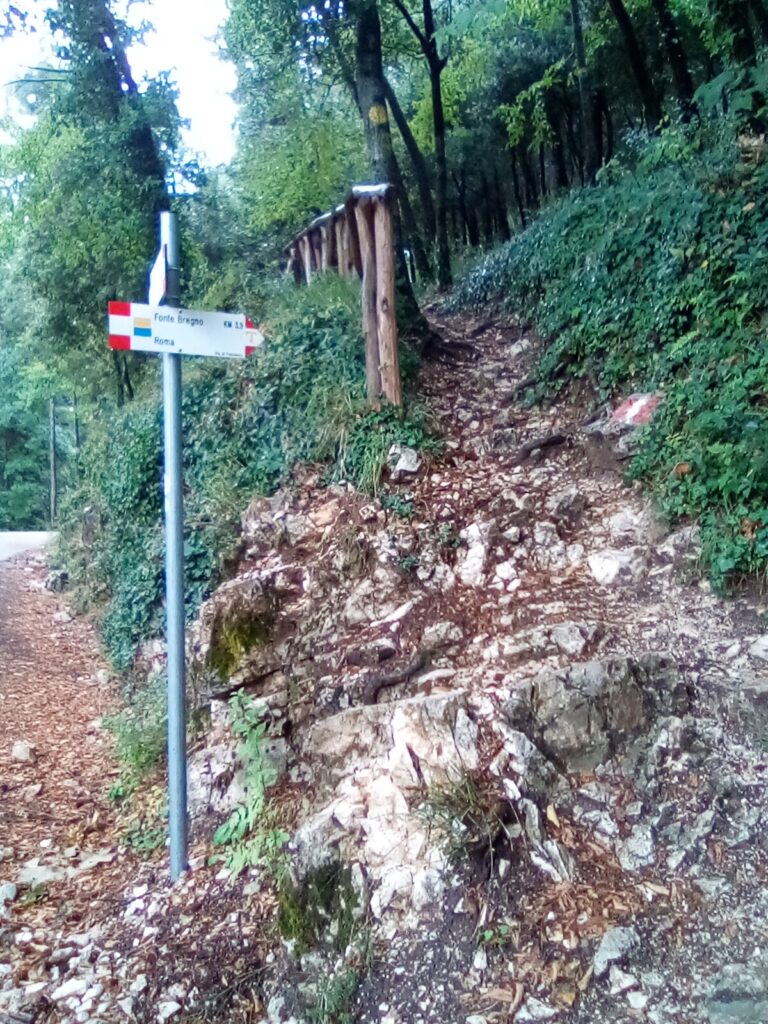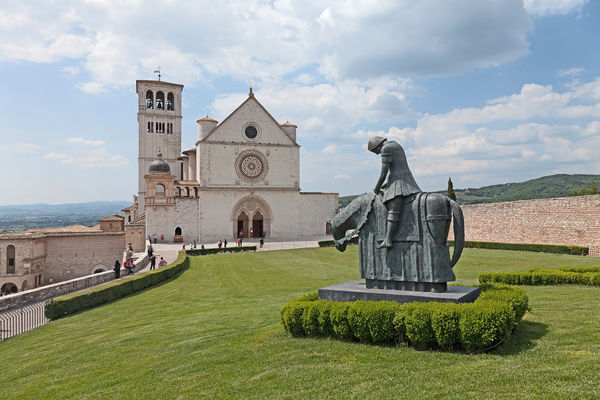
* * * *
As noted in the last post (From Jerusalem to Assisi), I flew over to Rome last August 27, a Saturday. On Tuesday, August 30, I took a train up to Assisi and met up with my brother and his wife. On Thursday, September 1, we started hiking back to Rome, via the Way of St Francis.

But not before I got a &^%#$ ticket – costing 30 Euros – for not validating my bus pass, in Assisi. It happened on the ride back from the Basilica of San Francis, at right, on the 31st, but it wasn’t my fault. Two knuckleheads in front of me had trouble making change (or whatever). A long line started forming behind me, so the driver told us – starting with me – to “go to the back of the bus.” That’s where, supposedly, there was another machine to validate your bus ticket.
For whatever reason I didn’t validate the pass, possibly because I didn’t see any such machine. So, when we got back to the train station in Assisi – a short walk from our lodging – an officious-looking official magically appeared and announced the aforementioned fine for failure to validate. I protested long, hard and loud – “but the driver told me to go to the back of the bus!” – but to no avail. It was all, “No comprendo,” or however they say it in Italy.
Not a good start to what was supposed to be a pilgrimage to enlightenment.
But this post is supposed to be about some highlights of the trip, so I’ll move on. Which is another way of saying that now that the project is over, it’s time to start the post-mortems.
For starters, the original proposed route was 154 miles, from Assisi to Rome. Specifically back to St. Peter’s Basilica in Vatican City, in Rome. But after our night spent in Piediluco on September 7, one of our party developed a temporary (GI) health problem. Aside from that, the weather forecast for September 8 was for really heavy rains. So instead of hiking that day we had to take a bus back to Trevi, then a train to Rieti – our destination for Friday, September 9 – then take a bus back to Poggio Bustonne, our reserved lodging for September 8.
That took off the 13.5 mile hike scheduled for that day (9/8/22), which was another good reason for the bus-train-bus alternative. (Along with the really heavy rain.) The net result was to round down our total miles hiked from 154 to 140 miles. Which we did in 18 days, from September 1 to the 18th. But we took days off from hiking on September 4, September 10, and September 15. Of course we didn’t hike on September 8, but that wasn’t what you could call a day off.
That is, the bus-train-bus travel day wasn’t what you could call a day off.
* * * *
Some other observations: Much of the Way of St. Francis is like the Appalachian Trail. Except that it’s over, up, down and around the Apennine Mountains, not the Appalachians.
Like the Appalachian Trail, there were many days with very few places to stop for refreshment during the day. It wasn’t that unusual to go a whole day’s hike, of 10 or 12 miles or more, without any of those stops so prevalent on the Camino Frances (French Way). (On the other hand, in Italy you could still always look forward to a hot shower and a cold beer at the end of the day.)
I suppose there’s a chicken-and-egg question here. The Camino Frances is big business. Lots of places to stop and refresh because there are lots of pilgrims hiking. But such a cafe would have a hard time surviving on the Way of St. Francis, because of so few pilgrims. One suggestion to improve things: Construct shelters every five or ten miles, with picnic tables – or one at least – so weary pilgrims could stop and at least put our feet up and our packs down.
Also, my 8th grade math teacher taught us that the shortest distance between two points was a straight line. However, that rule doesn’t apply to the Way of St. Francis. And that led me to wonder, “Why did St. Francis follow this ‘path?‘” Back and forth, up and down, full of zig-zags, switchbacks and cut-backs. And why wouldn’t he take the smoother route along the valley that beckoned down below? (The smooth path that the train takes from Rome up to Assisi.)
As best I can tell, Francis never actually hiked this one path all at once. Instead “the Way” seems to be an amalgam of trips he took during his lifetime, often responding to requests from a nearby village or town, to help out in an emergency. (Including one literal “wolf at the door.”)
Another note: Earlier this summer, before leaving for Rome, I read that Europe was having a severe drought. But we seem to have brought some rain with us, at least in Italy and at least along the Apennines between Assisi and Rome. Which often turned the Trail into a deadly combination of gumbo-like muck, caking around the bottom of your shoes, and slippery-slick rocks and gravel, especially treacherous hiking down one of those many switchbacks or cutbacks.
Which raises the question, “What kind of fool would put himself through such an ordeal?” And that’s a question I found myself asking quite often on the Trail, especially during the early days of the hike. The answer I came up with? The idea on such a trek is to push beyond your limits. To ask yourself at least once a day, “What the heck am I doing here?” Or in my case, “What sane 71-year-old would spend good money just to put himself through all this?”
And then keep going…
On the St. Francis, the hiking is often rugged, rocky, sticky and/or slippery, like after a torrential rain the night before. Zig-zag, east, west, north, south, repeat, up, down, round and around. Whereas on the Camino Frances, once you get past Pamplona you’re heading straight west. It’s much harder to get lost, and there are a lot more friendly locals to help you get back on track.
Another feature of such a pilgrimage, sleeping in a different bed pretty much every night, and having to figure out a different shower set-up every late afternoon. Which made Rome such a great place to reach: Getting to sleep in the same bed four nights in a row.
Then there was our one 15-hour day. There was a mix-up in addresses for our rental. One note said Ferrentillo, the other said Macenano. We passed Macenano in the dark and hiked the extra three miles to Ferrentillo, only to find out the rental was back in Macenano. (The closest I came to crying the whole trip.) By that time it was 10:30 at night, and nobody relished hiking back the 90 minutes or so, in the dark. Fortunately, one of our party approached a group of three local ladies, and through some combination got us a ride back to Macenano, free of charge. That could well be the biggest highlight of the ordeal, seeing how nice Italian people can be.
* * * *
There’s more to come in later posts, but this is supposed to be a spiritual blog. On that note, while hiking in Italy I faithfully kept up with my Daily Office Readings. And in September they included three major feast days: Holy Cross Day on September 14, St Matthew, Evangelist on September 21, and St Michael and All Angels, on September 29. You can see a quick take on these feast days at October 2018’s On Holy Cross, Matthew, and Michael – “Archangel.”
That October 2018 post talked about the Book of Common Prayer used by the Episcopal Church, and how it says the idea of purgatory is both a “Romish doctrine” and “repugnant to the Word of God.” On the other hand, there’s the painting below, of the Archangel Michael reaching to save souls in purgatory. Which brings up the fact that without purgatory, your dying day turns out to be a pass-fail test. You’re either in or you’re out. You either go to heaven or “down, down the down-down way.” But with purgatory you get another chance.
You get a chance to enter that “intermediate state after physical death,” where some of those “ultimately destined for heaven” can first undergo “purification, so as to achieve the holiness necessary to enter the joy of heaven.” Which to me, means another chance of getting to heaven. And who knows, maybe a challenging pilgrimage like my recent hike on the Way of St. Francis is, in its own way, a form of purgatory. And who knows, maybe that hot shower and cold beer at the end of each day’s hike was – in its own way – a metaphor, a foretaste of the Heavenly Banquet to Come. First comes the harsh reality of negotiating the twists and turns of life here on earth, followed by the metaphoric “hot shower and cold beer.”
So the idea of purgatory gives me another chance at that metaphoric “hot shower and cold beer” at the end of my earthly life. Which is why I ended that October 2018 post by saying, “here’s to Michael (archangel), and his reaching out to save souls in purgatory…”
“Hey, I’ll take all the help I can get!”
* * * *

* * * *
I took the top photo, one of many many switchbacks we saw hiking from Arrone to Piediluco, on September 7, 2022. By the way, Piediluco is a swanky resort area, by the Lago (Lake) di Piediluco. So the best fiscally responsible one-night rental option – at the Hotel Miralago, Piediluco – was one room with three beds right next to each other. They had a great breakfast buffet though!
“As noted in the last post…” The full title, From Jerusalem to Assisi – 2022.
Re: The bus-pass ticket. In hindsight I can see the logic. An unvalidated pass can be used again for a free ride. (But 30 &^%$# Euros?)
Re: “Post mortem.” The link is to Guide to Post-Mortem in Business: “a process that helps improve projects by identifying what did and didn’t work, and changing organizational processes to incorporate lessons learned. The Project Management Book of Knowledge (PMBOK) refers to this activity as ‘lessons learned.’” Also, according to mors, mortis [f.] M – Latin is Simple Online Dictionary, the plural form of mortem is “mortes,” not “mortems.” (I took two years of Latin in high school.)
Re: The Way of St. Francis as an “amalgam.” See for example The Way of St. Francis: Walking 550 Kilometers Along One of the World’s Greatest Pilgrimages:
St. Francis is said to have taken literally the scripture passage, “preach the good news to all creatures.” My favorite story focuses on the historic town of Gubbio where residents were haunted by a wolf that had developed a taste for human flesh. They begged St. Francis to intervene with the fearsome creature and then were amazed when the wolf sat peacefully at his feet while the two made a bargain.
The bargain: “If the townspeople would feed him daily, the wolf would leave them alone.”
“The closest I came to crying…” Not really, though I was concerned.
Re: Feast days in September. My DOR Lectionary book also included the Nativity of the Blessed Virgin Mary, on September 8, the “Christian feast day celebrating the birth of the Blessed Virgin Mary.” For more details see the link.
The lower image is courtesy of the Wikipedia article on St. Michael, captioned, “Guido Reni‘s painting in Santa Maria della Concezione, Rome, 1636 is also reproduced in mosaic at the St. Michael Altar in St. Peter’s Basilica, in the Vatican.”
* * * *